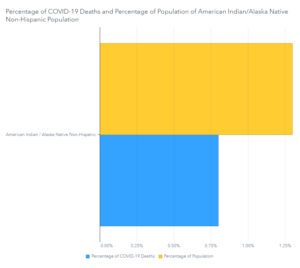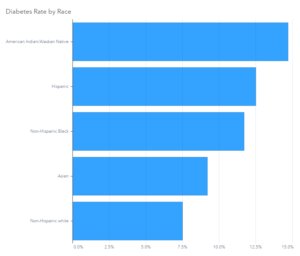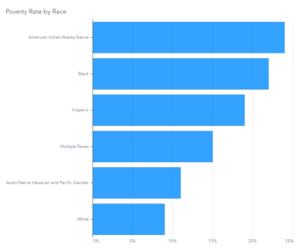
Understanding COVID-19 data: Examining data behind racial disparities
This piece is part of a series, presented by our partner SAS, that explores the role of data in understanding the COVID-19 pandemic. SAS is a pioneer in the data management and analytics field. (Check out other posts in the series on our Get Smart About COVID-19 Misinformation page.)
by Mary Osborne
Are communities of color at greater risk for COVID-19? The question of COVID-19 racial disparities has circulated across media outlets since the start of the pandemic. Science tells us that viruses do not target individuals by race or ethnicity, and yet, this novel virus significantly impacts communities of color in disproportionate ways.
To understand why communities of color are disproportionately impacted by COVID-19, we must look beyond race alone and consider other risk factors that may draw dividing lines. By examining why certain populations are more severely impacted than others, we can begin to identify the underlying causes. To do that, we have to look at the data. Although the data is limited within many communities of color, there is enough to better understand the impact of COVID-19 in certain communities.
Data has demonstrated how a person’s age or underlying medical conditions can be the difference between surviving COVID-19 or succumbing to it. But are there other risk factors to be considered and could any of those factors be tied to racial inequalities?
Population, race and COVID-19
It’s no secret that minority populations have been greatly affected by the COVID-19 pandemic, often at rates that are disproportionate to those of white people. The Black Non-Hispanic population has been hit particularly hard. While they represent 13% of the population in the United States, Black Non-Hispanics comprise over 22% of COVID-19-related deaths.
The disparities in cases and deaths by race vary from state to state, driven by percentages of population. However, a negative trend has emerged in one of the nation’s smallest populations — the American Indian/Alaska Native Non-Hispanic (AI/AN) group. AI/AN people make up around 1.5% of the U.S. population but have experienced almost 1% of total COVID-19 deaths. Let’s read that again: 1% of total COVID-19 deaths are attributed to the AI/AN population, which is enormous considering that this community is such a small percentage of the total population.
Source: US Centers for Disease Control and Prevention
The U.S. Centers for Disease Control and Prevention (CDC) have reported that the AI/AN population has a case rate that is 2.8 times higher than the White population, a death rate that is 1.4 times higher than the White population, and a hospitalization rate that is 5.3 times higher than the White population. The hospitalization rate is higher for this population than any other population in the U.S.
Source: US Centers for Disease Control
Secondary risk factors and healthcare access
Yet, the COVID-19 numbers we see in the AI/AN population aren’t dissimilar to those seen in other communities of color. This is likely because they may share risk factors with other minority populations. Similar to members of the Black and Hispanic populations, many Native American families live in close quarters — sharing their homes with more than one generation or extended family. That is partially unique to the AI/AN population because housing on reservation lands is limited, and an increase in the Native American population in the last decade has put a strain on housing resources. These types of living arrangements pose a higher risk of spreading diseases like COVID-19.
Within the AI/AN population, diabetes, obesity and hypertension have emerged as factors that increase risk of severe COVID-19 disease and the need for hospitalization. According to the American Diabetes Association, this disease is more prevalent in the AI/AN population than in any other racial or ethnic group. And AI/AN people are 50 percent more likely to suffer from obesity than Non-Hispanic white people. Hypertension is also common in this population, especially among people with diabetes.
Source: American Diabetes Association
Economic impacts
The long-term economic impacts from the virus also are disconcerting. AI/AN people have the highest poverty rates of any other U.S. racial ethnic group. Sociologist Beth Redbird from the Institute for Policy Research has found unemployment to be the most significant factor driving poverty in Native American populations. Given the current uncertainty with job markets and employment, an improvement in poverty rates is unlikely.
Source: U.S. Census Bureau/American Community Survey
Access to healthcare is another factor to consider. In some cases members of the AI/AN communities drive an hour or more to reach a medical provider. This is further complicated by a lack of transportation on most reservations. The Indian Health Service (IHS) is underfunded and lacks medical providers, equipment and facilities to handle critical patients. It runs 24 hospitals, which have fewer than 71 ventilators and just 33 ICU beds.
So, are there COVID-19 racial disparities?
We know that the color of one’s skin doesn’t make a person more susceptible to COVID-19. But what we’ve seen from the data is that AI/AN communities are disproportionately affected because of other contributing factors. These same factors amplify the risk of COVID-19 among all communities of color.
This pattern of impact isn’t unique to COVID-19 — other diseases behave in much the same way. Instead, COVID-19 has placed a necessary spotlight on these issues because of its devastating effects. The data reaffirms that more research is needed —regarding inequality of healthcare access and how certain populations are affected by viruses like COVID-19. We need to increase society’s diligence to understand and address the unbalanced systems affecting communities of color. While the AI/AN population is often overlooked because of its small numbers, statistical insignificance doesn’t mean members of these communities are insignificant.
Other articles in this series:
- Comparing data across countries.
- Comparing data across time.
- Case fatality rate vs. mortality rate vs. risk of dying.
- Age isn’t everything.
 About SAS: Through innovative analytics software and services, SAS helps customers around the world transform data into intelligence.
About SAS: Through innovative analytics software and services, SAS helps customers around the world transform data into intelligence.



